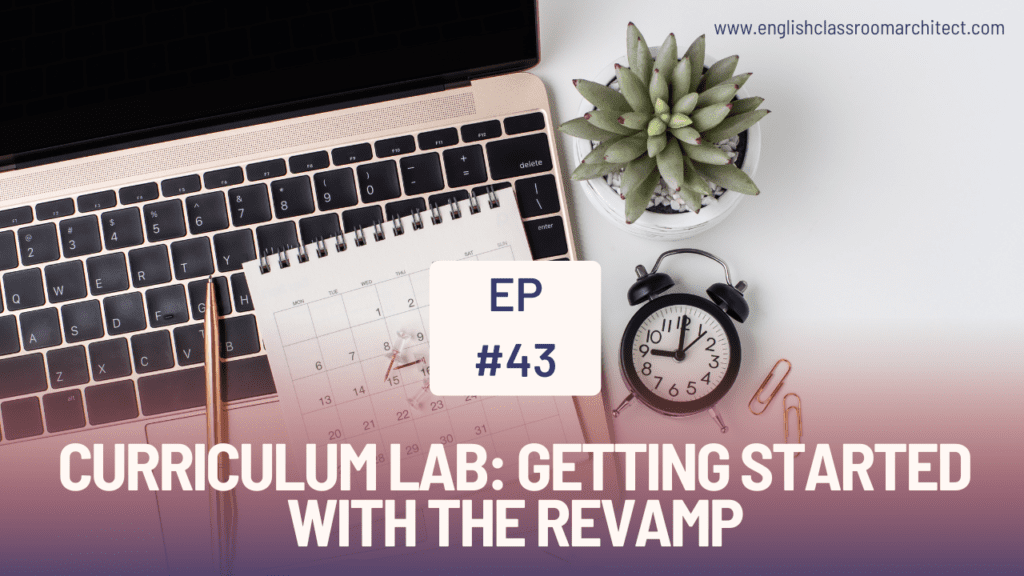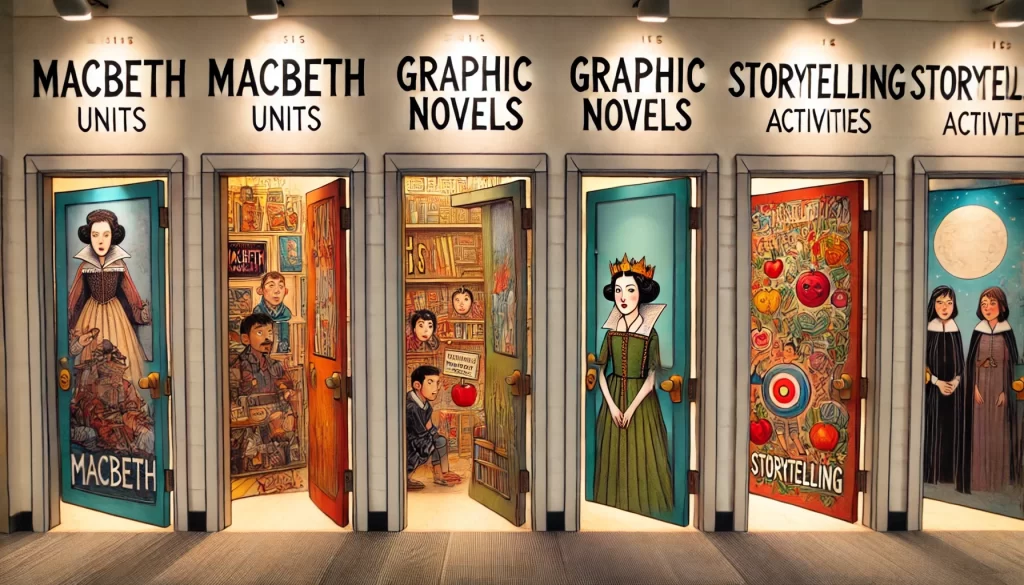
Episode Description
I’m back to curriculum planning, and this time, I’m blowing it all up! After a brief hiatus, I’m relaunching the podcast with an inside look at my ambitious 10th grade honors curriculum revamp. Three weeks in, and it’s a beautiful mess of sticky notes, midnight inspirations, and a few stubborn units. But amidst the chaos, a surprising solution emerges.
In this episode, I dig into the process of completely revamping her 10th grade honors English curriculum. With 16 years of teaching experience and a fresh perspective after 4 years away from this specific course, I share insights, challenges, and innovative approaches to curriculum design, including how to start revamping English curriculum. From organizational tools to assessment strategies, pop culture integration to AI assistance, this episode offers a comprehensive look at modern curriculum planning.

Table of Contents

Key Topics Covered
- How to start revamping English curriculum
- Motivation for curriculum revamp
- Organizational tools and strategies
- Vision and essential questions
- Assessment planning and grading philosophy
- Creating a “literary lifestyle” for students
- Integrating pop culture and transmedia storytelling
- Using AI for curriculum evaluation and improvement
- Balancing standards with engaging content
- The power of rearranging units for better flow
Resources Mentioned
- Notion – Organizational tool for getting a bird’s-eye view of curriculum
- Claude AI – Used for curriculum evaluation and improvement suggestions
- Witches and Jesuits – Historical context for teaching Macbeth
- Black Barbie documentary – Mentioned in relation to transmedia storytelling discussion
- Barbie Instagram account – Recommended for examples of modern storytelling
Detailed Notes with Timestamps
00:01 – Introduction and context for the curriculum revamp – deciding how to start revamping English curriculum
01:02 – Motivation for Revamp:
- Returning to 10th grade honors after 4 years
- Applying new knowledge from curriculum development work
- Shifting from a “set of lessons” to a cohesive curriculum
03:20 – Organizational Tools:
- Google Docs for flexibility and accessibility
- Notion for bird’s-eye view and organization
- Importance of seeing all moving parts simultaneously
06:46 – Vision and Essential Questions:
- Umbrella concept: The nature of knowledge
- Addressing grade inflation, student apathy, absenteeism, and AI
- Progression: Core values > Umbrella concept > Year-long essential questions > Unit essential questions
09:52 – Assessment Planning:
- Mapped out 7 key assessments per quarter
- Focus on skill-based assignments clearly tied to summative assessments
- Open revision for 2 assignments per quarter
- Balancing graded and ungraded work
15:23 – Creating a “Literary Lifestyle”:
- Inspired by Lululemon’s approach to creating a lifestyle, not just a product
- Broadening the definition of “texts” to include social media, sports commentary, Netflix, etc.
- Encouraging critical thinking about students’ everyday media consumption
17:33 – “Brain Food” and Side Quests:
- Optional activities that don’t fit the main curriculum but support learning
- Exploring gamification to track participation
- Goal-setting integrated throughout the year
20:13 – Integrating Pop Culture and Transmedia Storytelling:
- Using examples like Barbie and Marvel’s WandaVision
- Exploring how stories are told across multiple platforms
- Connecting classic literature to modern storytelling techniques
23:03 – Using AI for Curriculum Evaluation:
- Utilizing Claude AI to analyze curriculum plans against standards
- Identifying areas for improvement (e.g., grammar, vocabulary, mechanics)
- Generating ideas for authentic integration of standards
25:47 – Balancing Standards with Engaging Content:
- Incorporating grammar and mechanics into existing units
- Example: Mad Libs activity for reviewing short stories and parts of speech
- Finding creative ways to address standards without adding time to units
29:08 – The Power of Rearrangement:
- Swapping the order of units for better thematic flow
- Connecting WandaVision unit to Beyoncé’s Cowboy Carter album study
- Recognizing how unit order impacts student understanding of concepts
32:20 – Innovative Teaching Strategies:
- Developing a class motto: “Question the page”
- Creating “Easter eggs” and callbacks between units
- Using Canva to teach about TV eras and Macbeth adaptations
36:41 – Reflections on the Process:
- Value of dedicated planning time
- Importance of revisiting and revising throughout the planning process
- Encouragement to question traditional unit arrangements

Tips for How to Start Revamping English Curriculum
- Take a holistic view: Start by considering your entire curriculum as a cohesive whole, not just individual units or lessons.
- Use organizational tools: Implement tools like Google Docs for flexibility and Notion for a bird’s-eye view of your curriculum.
- Define your vision: Establish an overarching concept or theme for the year (e.g., “the nature of knowledge”) to guide your planning.
- Rethink assessments: Map out key assessments for each quarter, focusing on skill-based assignments tied to summative assessments.
- Create a “literary lifestyle”: Broaden your definition of “texts” to include various media forms, encouraging students to think critically about their everyday content consumption.
- Integrate pop culture: Look for ways to connect classic literature with modern media, such as comparing TV shows or music albums to traditional texts.
- Use AI for evaluation: Consider using AI tools to analyze your curriculum plans against standards and identify areas for improvement.
- Balance standards and engagement: Find creative ways to incorporate required standards into engaging, pop-culture-infused content.
- Be flexible with unit arrangement: Don’t be afraid to rearrange units for better thematic flow and student understanding.
- Incorporate “brain food”: Design optional activities or “side quests” that support learning beyond the core curriculum.
- Develop a class motto or theme: Create a unifying element (like “Question the page”) to tie your curriculum together.
- Plan for cross-unit connections: Design “Easter eggs” or callbacks between units to create a more cohesive learning experience.
- Embrace technology: Utilize tools like Canva to teach both content and valuable digital skills.
- Allow for revision: Build in opportunities for students to revise their work, promoting growth and deeper understanding.
- Stay open to change: Be willing to adjust your plans as you go, always looking for ways to improve and engage your students.
Key Takeaways
- How to start revamping English curriculum in an organized way
- Curriculum planning benefits from a holistic, bird’s-eye view approach.
- Integrating pop culture can create a more engaging “literary lifestyle” for students.
- AI tools can provide valuable insights for curriculum evaluation and improvement.
- Rearranging units can lead to better thematic flow and student understanding.
- Balancing standards with engaging content requires creativity and intentional planning.
As you prepare for the upcoming school year, consider how you might apply some of these strategies to your own curriculum. Could rearranging your units lead to better connections? How might you integrate more pop culture to create a “literary lifestyle” for your students? Share your thoughts and experiences in the comments or reach out on social media!
